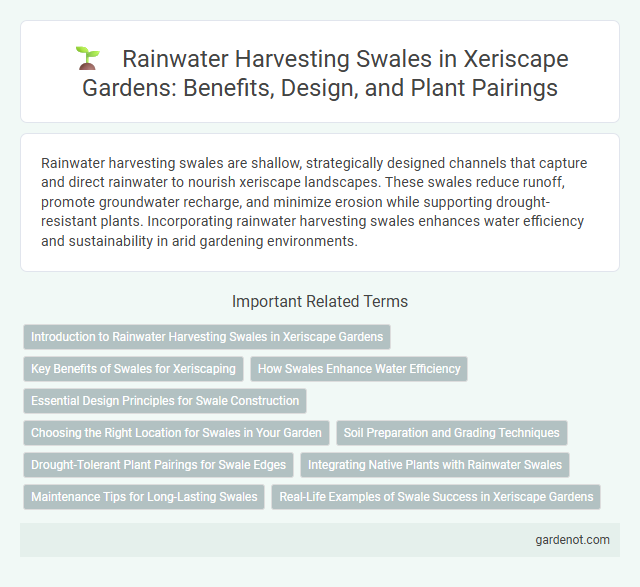Rainwater harvesting swales are shallow, strategically designed channels that capture and direct rainwater to nourish xeriscape landscapes. These swales reduce runoff, promote groundwater recharge, and minimize erosion while supporting drought-resistant plants. Incorporating rainwater harvesting swales enhances water efficiency and sustainability in arid gardening environments.
Introduction to Rainwater Harvesting Swales in Xeriscape Gardens
Rainwater harvesting swales are shallow, vegetated channels designed to capture and infiltrate stormwater in xeriscape gardens, enhancing water conservation. These swales slow runoff, promote groundwater recharge, and reduce erosion, creating a sustainable landscape that thrives in arid environments. Integrating native drought-tolerant plants within swales further optimizes water use efficiency and supports local biodiversity.
Key Benefits of Swales for Xeriscaping
Rainwater harvesting swales effectively capture and direct runoff, promoting groundwater recharge and reducing soil erosion in xeriscaping landscapes. These shallow, vegetated channels enhance water conservation by maximizing infiltration, which supports drought-tolerant plant growth and reduces irrigation needs. Swales also improve landscape resilience by filtering pollutants and maintaining soil moisture, contributing to sustainable, low-water-use garden design.
How Swales Enhance Water Efficiency
Swales enhance water efficiency by capturing and directing rainwater runoff into the soil, reducing erosion and promoting deep infiltration. Their gently sloped design slows water flow, allowing maximum absorption and minimizing water loss through surface runoff. Integrating swales in xeriscape landscaping optimizes water conservation by replenishing groundwater and supporting drought-tolerant plant growth.
Essential Design Principles for Swale Construction
Rainwater harvesting swales require careful grading to ensure slow infiltration and prevent erosion, with a shallow, broad channel shape optimized for maximum water retention. The swale should be lined with native drought-tolerant vegetation to stabilize soil and promote natural filtration of runoff. Proper placement on contour lines and incorporation of overflow outlets ensure effective water distribution and minimize flood risks in xeriscape landscaping.
Choosing the Right Location for Swales in Your Garden
Selecting the ideal location for rainwater harvesting swales in your xeriscape garden involves analyzing soil permeability and natural water flow patterns to maximize water retention and minimize erosion. Position swales along contour lines or gentle slopes where they can effectively capture runoff and promote groundwater infiltration. Avoid areas with heavy foot traffic or existing root systems to ensure durability and optimal plant growth within the swale design.
Soil Preparation and Grading Techniques
Effective rainwater harvesting swales require meticulous soil preparation, including deep tilling and organic matter incorporation to enhance infiltration and promote root growth. Grading techniques involve creating a gentle, level contour along the landscape to ensure optimal water flow and retention, minimizing erosion and runoff. Properly designed swales slow runoff velocity, allowing water to percolate into the soil, supporting drought-resistant xeriscape vegetation sustainably.
Drought-Tolerant Plant Pairings for Swale Edges
Rainwater harvesting swales improve water retention by directing runoff to drought-tolerant plants such as lavender, sedum, and ornamental grasses along their edges. These species thrive with minimal irrigation, enhancing soil stabilization and reducing erosion while maximizing water efficiency in xeriscape designs. Incorporating native succulents and drought-endemic shrubs further optimizes swale performance and biodiversity in arid landscapes.
Integrating Native Plants with Rainwater Swales
Rainwater harvesting swales enhance xeriscape gardens by efficiently capturing and directing runoff to native plants, promoting water conservation and soil retention. Integrating drought-tolerant native species such as California poppies, yarrow, and desert willow ensures deep root systems that stabilize swales and maximize water absorption. This synergy between swale design and native vegetation reduces irrigation needs and supports local biodiversity in arid landscapes.
Maintenance Tips for Long-Lasting Swales
Regular inspection of rainwater harvesting swales ensures debris removal and prevents clogging, maintaining water flow and soil absorption. Periodic reshaping of swale banks preserves structural integrity and optimizes water retention capacity. Integrating native drought-tolerant plants around swales reduces erosion and supports long-term system sustainability in xeriscape landscapes.
Real-Life Examples of Swale Success in Xeriscape Gardens
Rainwater harvesting swales have proven highly effective in xeriscape gardens by capturing and directing runoff to nourish drought-tolerant plants, as seen in Arizona's Sonoran Desert landscapes where native vegetation thrives with minimal irrigation. In California's Mediterranean climate, swales integrated into xeriscape designs significantly reduce water usage while improving soil moisture retention for succulents and ornamental grasses. Research from Utah reveals that gardens employing swale systems experience up to a 40% increase in plant survival rates during extended dry periods, highlighting swale efficiency in water conservation and landscape resilience.
Rainwater harvesting swale Infographic

 gardenot.com
gardenot.com